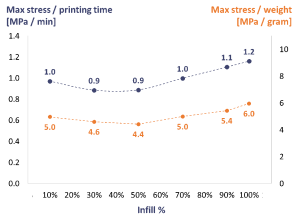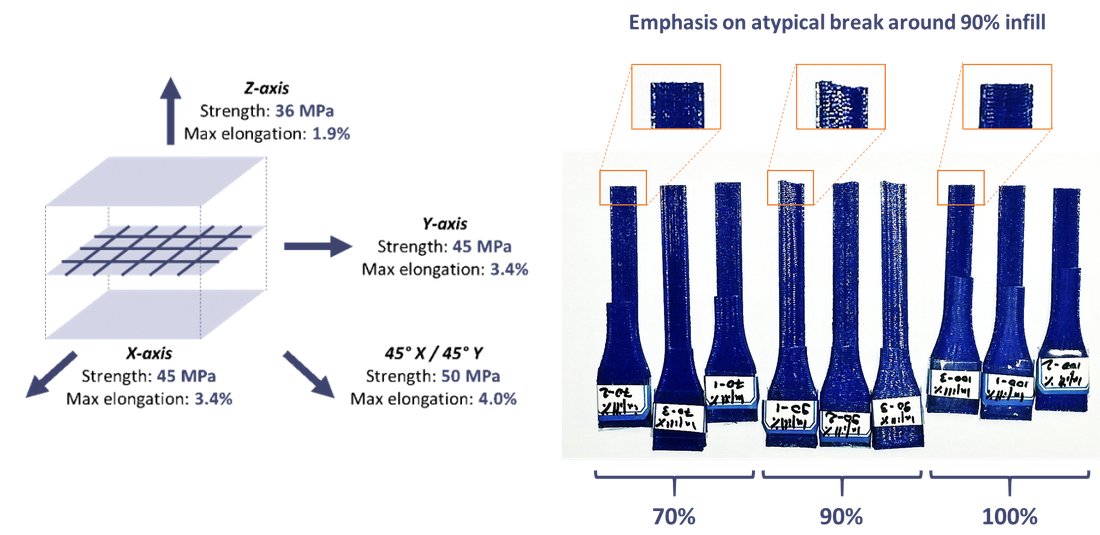3DMatter Researches Effects of Infill Percentages, Patterns, and Layer Height on 3D Printed Structures
 As 3D printing continues to thrive and progress as a technology, innovators and makers seem to be on an infinite path for changing the world and manufacturing as we know it, with incredible new designs. Along with this comes what almost seems to be an infinite number of new 3D printer and filament manufacturers along with a wide array of peripheral products, educational materials, and everything we could hope to choose from to fulfill our 3D printing needs.
As 3D printing continues to thrive and progress as a technology, innovators and makers seem to be on an infinite path for changing the world and manufacturing as we know it, with incredible new designs. Along with this comes what almost seems to be an infinite number of new 3D printer and filament manufacturers along with a wide array of peripheral products, educational materials, and everything we could hope to choose from to fulfill our 3D printing needs.
 With the foundation set and so many tools at our fingertips, many are beginning to take a harder look quite simply now at how we can become better at 3D printing itself. This is a complicated subject, however, with so many different techniques and choices regarding 3D printing and settings. 3DMatter used a MakerBot Replicator (employing FDM) and PLA material to do some specialized research into the effects of:
With the foundation set and so many tools at our fingertips, many are beginning to take a harder look quite simply now at how we can become better at 3D printing itself. This is a complicated subject, however, with so many different techniques and choices regarding 3D printing and settings. 3DMatter used a MakerBot Replicator (employing FDM) and PLA material to do some specialized research into the effects of:
- Infill percentage
- Layer height
- Infill pattern
3DMatter endeavored to see how the following influenced a print:
- Maximum stress
- Elongation at break
- Rigidity (Young Modulus)
- Yield stress
Finding that most users are focusing on and looking for either high quality level or less financial investment, or both, they geared the study around the questions that those agendas bring forth. With all of these focuses, what the researchers found, broadly, was that:
- With a 90% infill, elongation is at its lowest, and would seem to be something users would want to consider.
- Quality and layer height seem to go hand in hand, and quality deteriorates as layer height is increased.
- Linear (tilted 45°) and diagonal infill patterns yield the best results, with the caveat that only exposed decorative designs should be used—and then only when they are integral to design.
Regarding anisotropy, which relates to directional dependence, findings showed that issues definitely tend to arise on the Z-axis at a rate of 20-30%, with half that rate also resulting in elongation breakage. The interface between layers is weaker, and thus responsible for complications.
 When it came to the study of infill percentages, the researchers did have some surprises. They found that ‘evolution of [specimen strength] is not linear: the strength gained per percentage point of infill also increases.’ With more infill obviously comes the need for more material and more time for 3D printing, which does have consequences on strength as well.
When it came to the study of infill percentages, the researchers did have some surprises. They found that ‘evolution of [specimen strength] is not linear: the strength gained per percentage point of infill also increases.’ With more infill obviously comes the need for more material and more time for 3D printing, which does have consequences on strength as well.
The greatest surprise though, according to 3DMatters research, was that elongation at break remained consistently at 2.8%, until 90% infill, where it dropped to 2.0%. The theory behind this is that with the much higher infill, ‘faults’ are created due to the lack of gaps in the mesh. Small ‘air voids’ cause strain, and thus, breakage, which seems specific to the 90% infill rate, yet with ‘lower elongation at breakage.’ At 100% there are no more voids and all of the filaments are touching. The yield stress test revealed the same results, thus validating the information on lower elongation breakage at 90% infill.
Regarding rigidity, they used a non-adjusted curve to test this, which suggested that there is a positive relationship between infill percentage and rigidity, but if they were to use a more adjusted curve, it would be in the same range as rigidity for PLA.
This research is good, broad information for anyone trying to weigh out the positives and negatives that could be caused by particular settings. There are other items that could be included in a more advanced research study to include different materials other than just PLA, as well as different temperatures and speeds. Other 3D printers could be included in for more advanced testing purposes as well.
Does this information support findings you have seen while 3D printing your own items? Will this change how you choose settings in the future? Tell us your thoughts in the Researching Infill forum over at 3DPB.com.
[source: 3DMatter ]Subscribe to Our Email Newsletter
Stay up-to-date on all the latest news from the 3D printing industry and receive information and offers from third party vendors.
You May Also Like
Profiling a Construction 3D Printing Pioneer: US Army Corps of Engineers’ Megan Kreiger
The world of construction 3D printing is still so new that the true experts can probably be counted on two hands. Among them is Megan Kreiger, Portfolio Manager of Additive...
US Army Corps of Engineers Taps Lincoln Electric & Eaton for Largest 3D Printed US Civil Works Part
The Soo Locks sit on the US-Canadian border, enabling maritime travel between Lake Superior and Lake Huron, from which ships can reach the rest of the Great Lakes. Crafts carrying...
Construction 3D Printing CEO Reflects on Being Female in Construction
Natalie Wadley, CEO of ChangeMaker3D, could hear the words of her daughter sitting next to her resounding in her head. “Mum, MUM, you’ve won!” Wadley had just won the prestigious...
1Print to Commercialize 3D Printed Coastal Resilience Solutions
1Print, a company that specializes in deploying additive construction (AC) for infrastructure projects, has entered an agreement with the University of Miami (UM) to accelerate commercialization of the SEAHIVE shoreline...






























